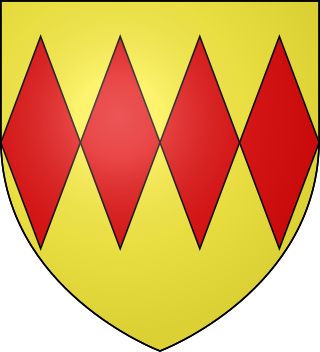
Henry de Pinkeney, 1st Baron Pinkeney (died 1301), Lord of Weden-Pinkeney, was an English noble. He served in the wars in Scotland and was a signatory of the Baron's Letter to Pope Boniface VIII in 1301.

Henry de Pinkeney, 1st Baron Pinkeney (died 1301), Lord of Weden-Pinkeney, was an English noble. He served in the wars in Scotland and was a signatory of the Baron's Letter to Pope Boniface VIII in 1301.
Henry was a younger son of Henry de Pinkeney [1] and Mary de Wahul. He succeeded to his brother's estates and titles upon the death of his brother Robert de Pinkeney in 1296. His brother Robert was a competitor for the Crown of Scotland in 1290, from their great-grandmother Marjorie, an alleged natural daughter of Henry, Earl of Huntingdon, son of King David I. [2]
He died in 1301, without any issue. [3] His will granted his lands to King Edward I of England.

Earl of Elgin is a title in the Peerage of Scotland, created in 1633 for Thomas Bruce, 3rd Lord Kinloss. He was later created Baron Bruce, of Whorlton in the County of York, in the Peerage of England on 30 July 1641. The Earl of Elgin is the hereditary Clan Chief of Clan Bruce.

Ralph de Stafford, 1st Earl of Stafford, 2nd Baron Stafford, KG, of Stafford Castle and Madeley Castle in Staffordshire, was an English nobleman and a notable soldier during the Hundred Years' War against France.

Baron Balfour of Glenawley or Clonawley, in the County of Fermanagh, was a title in the Peerage of Ireland. It was created in 1619 for Sir James Balfour, younger brother of the 1st Lord Balfour of Burleigh. It refers to the barony of Clanawley.
George Hamilton, 3rd Earl of Abercorn died unmarried in Padua on a voyage to Rome. He was succeeded by Claud Hamilton, heir of Claud Hamilton, 2nd Baron Hamilton of Strabane, second son of the 1st Earl of Abercorn.

Thomas Burgh, 1st Baron Burgh of Gainsborough,, de jure 5th Baron Strabolgi and 7th Baron Cobham of Sterborough, was an English peer. In 1513 he was knighted on Flodden Field, where he was one of the King's Spears, a bodyguard of King Henry VIII. He later became Lord Chamberlain to Anne Boleyn. He was also one of the twenty-six Peers summoned to the trial of Anne Boleyn in May 1536.

Walter Bailloch, also known as Walter Bailloch Stewart, was distinguished by the sobriquet Bailloch or Balloch, a Gaelic nickname roughly translated as "the freckled". He was the Earl of Menteith jure uxoris.

John Montagu, 3rd Earl of Salisbury and 5th and 2nd Baron Montagu, KG was an English nobleman, one of the few who remained loyal to Richard II after Henry IV became king.

Thomas Burgh, 3rd Baron Burgh of Gainsborough,, de jure 7th Baron Strabolgi and 9th Baron Cobham of Sterborough, was the son of William Burgh, 2nd Baron Burgh and Lady Katherine Clinton, daughter of Edward Clinton, 1st Earl of Lincoln and Elizabeth Blount, former mistress of King Henry VIII. He was one of the peers who conducted the trial of the Duke of Norfolk in 1572.

Thomas Cromwell, 1st Earl of Ardglass, 11 June 1594 to 20 November 1653, was an English nobleman, son of Edward Cromwell, 3rd Baron Cromwell and his second wife Frances Rugge.
Viscount Teviot was a title that was created twice in the Peerage of Scotland. The first creation was on 20 October 1685 for the Honourable Robert Spencer of the Spencer family. He was the son of William Spencer, 2nd Baron Spencer of Wormleighton and younger brother of Henry Spencer, 1st Earl of Sunderland. It became extinct upon his suicide in 1694.
Baron Astley (1295) was created by writ of summons dated 23 June 1295 for a family which had lived at Astley, Warwickshire, England since the time of Henry I. Sir Thomas de Astley who was killed in the Battle of Evesham in 1265 married twice. From Sir Thomas's first marriage to Joan de Blois descended the Barons Astley.

Sir Robert de Pinkeney, Baron Pinkeney was a 13th-century English noble. He was a competitor for the Crown of Scotland and died in 1296.
James Balfour, 1st Baron Balfour of Glenawley or Clonawley, was a Scottish nobleman and courtier who was one of the chief undertakers in the Plantation of Ulster. His third marriage to Anne Blayney caused a notable scandal.

Fulk le Strange, 1st Baron Strange of Blackmere was an English noble. He fought in the wars in Gascony and Scotland. He was a signatory of the Baron's Letter to Pope Boniface VIII in 1301.

John FitzReginald, also known as John FitzReynold, Lord of Blenlevenny was an English noble. He was a signatory of the Barons' Letter of 1301.

Henry de Tregoz, 2nd Baron Tregoz , Lord of Goring was an English noble. He served in the wars in Scotland and was a signatory of the Baron's Letter to Pope Boniface VIII in 1301.

Robert Hastang, 1st Baron Hastang , Lord of La Desiree, Badenhall, Chebsey and Leamington Hastang was an English noble. He fought in the wars in Scotland. He was a signatory of the Baron's Letter to Pope Boniface VIII in 1301.

Edmund Deincourt, 1st Baron Deincourt, Lord of Thurgarton, Blankney and Branston was an English noble. He served in the wars in France and Scotland and was a signatory of the Baron's Letter to Pope Boniface VIII in 1301.

Philip de Kyme, 1st Baron Kyme, Lord of Kyme, was an English noble. He served in the wars in Wales, Gascony and Scotland and was a signatory of the Baron's Letter to Pope Boniface VIII in 1301.

Ralph de Grendon, 1st Baron Grendon, Lord of Grendon, was an English nobleman. He served in the wars in Scotland and was a signatory of the Barons' Letter of 1301 to Pope Boniface VIII in 1301.